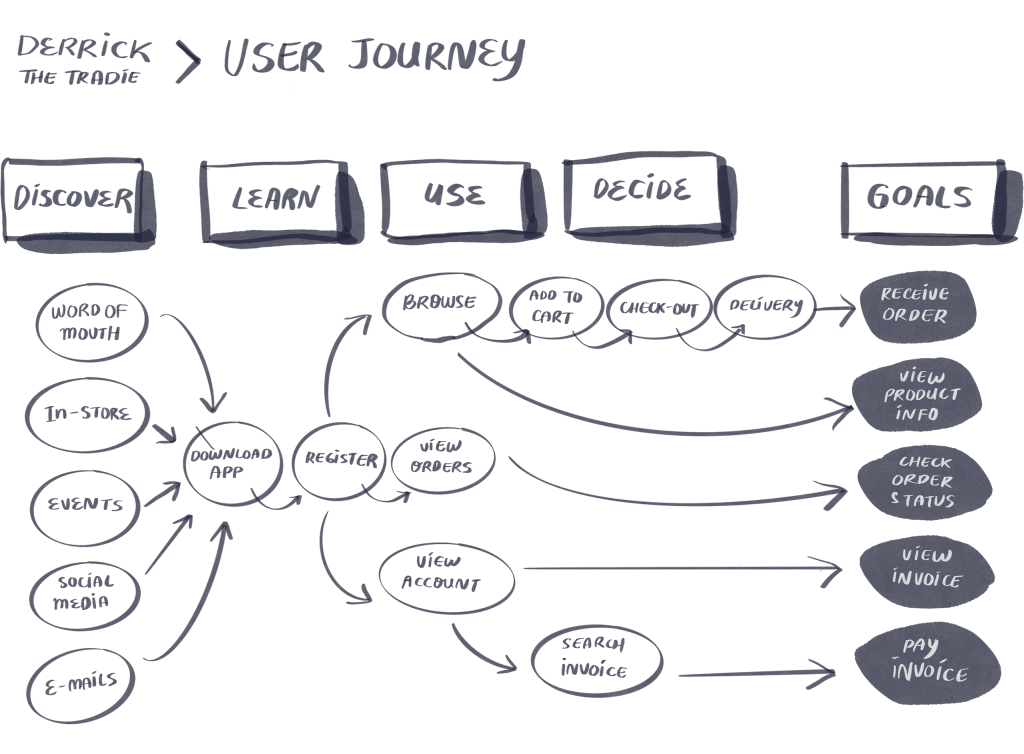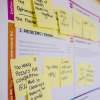Mapping a user journey is about taking a walk in a customer’s shoes. By understanding how they behave and what they want or need, you’re more likely to turn them into loyal fans instead of one-off buyers.
A user journey usually starts from your customer discovering your business to them taking a positive action towards your business in the form of buying, trialling, hiring or subscribing to your services.
As a digital design consultancy, we at Relab use user journeys heavily in our projects to create mobile apps, websites and other digital experiences. It helps us and our clients be on the same page on what we are building and improving.
Most of our maps revolve around generating online sales and leads or enriching the online user experience, but you can build maps for any customer experience such as an in-store purchase or live demos.
We typically do them on the first day of a Design Sprint, but you can create them as a standalone exercise. These are the vital things to research and have ready before a session:
- Your user personas
- Your goals for the user personas
- The key challenges faced by your user personas to achieve those goals.
For example, your user persona may be a mother, who is looking to buy toys for her kids.
The goal is for her to buy the toys you sell online. Based on available data, previous surveys and feedback, the key challenges hindering her to buy online from your business could be:
- Confusing or unclear product categories on your site which makes it difficult for her to find the exact item she wants
- The limited payment options available at checkout because the website only accepts PayPal
- Her lack of confidence in purchasing from a small online shop as opposed to a big retailer
If you are building a new website, you may not have existing user behaviour data to draw upon. In this case, you can study your competitors’ websites to see what and where they are lacking to build a better website.
How to map the user journey
The first item to get right off the bat is agreeing on the user personas, their goals and main issues. Many times, the hardest task in a session is getting everyone to see eye to eye on these parameters.
Once that’s done, we can start plotting what the map looks like for each user persona. Start with one user persona. The typical stages that a user goes through is “Discover”, “Learn”, “Use” and “Decide” before they achieve their goals. Obviously, you can create your own stages that are unique to your business. This is just a guide.
I must also stress that the goal for a user may not always be a purchase. It could be signing up to a newsletter, booking an appointment, downloading an information pack, or enquiring about your product or service. Furthermore, a user persona will have multiple goals.

Example of a User Journey Map
Take a look at the diagram above.
In this example, we have a user persona who is a handy man or a tradie called Derrick. We want him to use our app that lets him buy supplies and pay for job invoices.
During the “Discover” stage, Derrick may have heard about our app through several sources: word of mouth, in retail stores, events, social media and emails. He then learns that he can download the app to register an account in the “Learn” stage.
After he has registered on our app, he is now in the “Use” stage where he will be exploring our app. This is where it can branch off to several use cases before getting into the “Decide” stage that leads to user goals.
- He can start browsing products and then decide to buy it
- He can view orders and then decide to check on a particular order status
- He can view his account and then decide to view all his invoices
- He can search for invoices and then decide to pay outstanding invoices
”A typical user journey map will have many branches of use cases, especially for more complex and bigger websites or apps. This is when you need to set priorities in your project.
Based on the diagram above, you should pick a branch that is most likely to solve your issue or give the biggest impact to your business. For example, if sales have been lagging in your business, your first priority will be to increase sales on your app. Therefore, you can focus your energy on a particular branch or use case first, by building a better user experience and making it easier for them to purchase on the app, before tackling the remaining goals.

A defined User Journey focus
Here’s a video example of how simple it is to come up with a user journey map:
With any user mapping sessions, I generally advocate for simplicity as much as possible. Naturally, you will have several user personas for your business. Pick one or two personas that make up the majority of your customer base and then create the corresponding maps.
These maps help you stay on course towards your goals because it is easy to get overwhelmed when improving your website or app. You may feel that there are too many things to fix or build. You may also end up building something that doesn’t fix the issue or makes things worse. By mapping things out, you can prioritise tasks clearly, and effectively measure the success of your work.
And taking a walk in your customers’ shoes is always a good idea.







